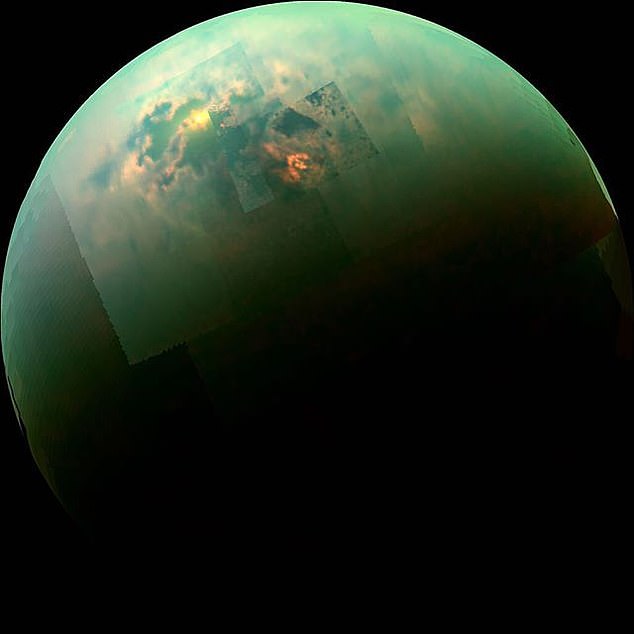Methane rain on Titan can create methane lakes 330 feet (100 metres) deep in the moon’s northern polar region.
The hydrological system on Titan is as varied as the water cycle on Earth, with some lakes lasting thousands of years and others mere seasons, researchers have found.
The findings are based on data taken by NASA’s Cassini spacecraft, which spent 13 years studying Saturn and its system until it was intentionally destroyed in 2017.
Beyond our planet, Titan is the only body in the solar system on the surface of which liquid matter can be stable.
Unlike on the Earth, however, Titan has polar lakes and seas made up not of water but of hydrocarbons.
This is because the daytime temperature on Titan averages a chilly -292°F (-180°C).
Although Titan’s methane seas had previously been studied, this is the first time the depth of the lakes have been determined.
The researchers found that the lakes could reach depths of over 330 feet (100 metres).
The lake’s transparency to the particular wavelength of radar the researchers used indicated that the bodies have a primarily methane-based composition.
But similar to the water cycle on the Earth, Titan has a full so-called ‘hydrological cycle’ of methane, connecting the moon’s atmosphere, surface and subsurface, researchers have found.
Models of Titan have suggested that the evaporation and precipitation rates of the moon’s methane changes with the seasons and evolve slowly.
NASA’s Cassini spacecraft previously suggested that some of Titan’s south polar lakes have shorelines that retreat during the moon’s summer.
But similar seasonal changes had not previously been seen in Titan’s north pole ‘lake district’, where the bodies of surface liquid are larger and more abundant.
In one study, planetary scientist Marco Mastrogiuseppe of the California Institute of Technology and colleagues used radar data from the final Cassini flyby of titan on April 22, 2017, to sound out the depths of a number of methane lakes found in Titan’s north polar regions.
The composition of the northern lakes is significantly different to that found in the only major lake of Titan’s southern hemisphere, Ontario Lacus, the researchers note.
Ontario Lacus is more ethane rich, they find.
‘These lakes, like others in the northern polar region [located far] from the larger seas, have liquid surface heights hundreds of metres above the sea level,’ Dr Mastrogiuseppe and colleagues write.
‘Thus, they are “perched” and likely fed by local rainfall.’
The researchers believe that the lakes were created thousands of years ago by methane rain dissolving rocks at the surface.
The lakes do not dry up because the rate at which the methane drains into the ground is less than the rate at which the bodies are topped up by rainfall.
In a separate study, planetary scientist Shannon MacKenzie of Johns Hopkins University and colleagues used Cassini’s radar and spectral imaging to examine three so-called ‘phantom lakes’ in Titan’s northern polar region.
These phantom lakes appeared on the surface during Titan’s winter, but had disappeared come the spring, seven years later.
The researchers have concluded that these phantom bodies were shallow ponds, which had either evaporated or drained into the ground as temperatures warmed.
The lakes would either need to have a composition of pure methane, to completely evaporate, or underlying deposits that are porous enough to allow less volatile ethane to drain out of the ponds.
Understanding the nature of these phantom lakes helps constrain the time it takes for surface liquids to be removed from Titan’s north pole, say the researchers.
‘The location, size and longevity of surface liquid reservoirs affect sediment processing, seasonal weather, climate evolution, and even, perhaps, their habitability,’ the researchers write in their paper.
‘As solubility of the possible non-polar mixtures is generally low, short-lived lakes might be nutrient-poor and thus have low astrobiological potential.’
The full findings of the study are published in a pair of papers in the journal Nature Astronomy.













